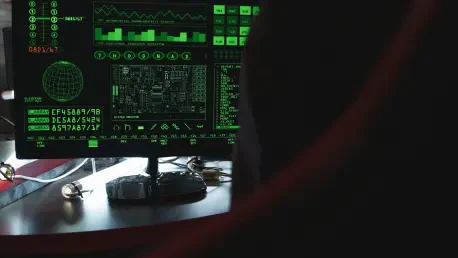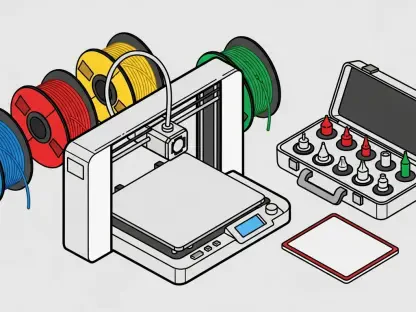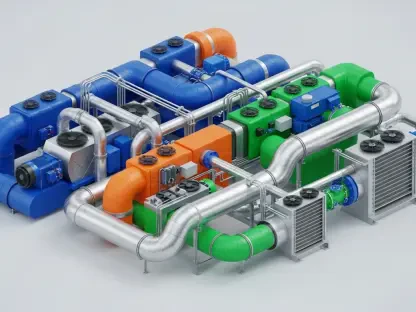In an era marked by fluctuating markets and geopolitical tensions, organizations face an escalating challenge in securing cyber-physical systems (CPS), which integrate digital and physical processes in critical sectors like industrial control and healthcare. These systems, often overlooked by conventional cybersecurity protocols due to their hybrid nature, are becoming prime targets for threats amplified by economic instability. A recent comprehensive survey of over 1,100 professionals spanning information security, operational technology (OT) engineering, and facilities management has revealed a troubling reality: external pressures such as supply chain disruptions and regulatory shifts are intensifying vulnerabilities in CPS environments. This growing concern underscores the urgent need for adaptive strategies to protect assets that bridge the gap between virtual networks and tangible infrastructure, as the stakes for operational continuity and public safety have never been higher.
Supply Chain Disruptions Amplify Cyber Risks
The ripple effects of global economic policies and geopolitical unrest have placed immense pressure on supply chains, directly impacting the security of cyber-physical systems. According to the survey, nearly half of the respondents reported that supply chain interruptions have heightened cyber risks to CPS assets and processes, creating a domino effect across industries reliant on seamless operations. These disruptions often stem from sudden policy changes, trade barriers, or regional conflicts, which complicate the timely delivery of critical components and updates necessary for maintaining secure systems. As a result, organizations find themselves grappling with delayed patches or outdated equipment, leaving them exposed to potential exploits. The data further indicates that 67 percent of companies are now reassessing the geographic spread of their supply chains, opting for localization or diversification to mitigate reliance on volatile regions and reduce exposure to external shocks that could compromise system integrity.
Beyond the immediate logistical challenges, the financial strain of supply chain issues adds another layer of complexity to CPS security. Budget constraints driven by economic uncertainty often force organizations to prioritize cost-cutting over cybersecurity investments, even as the threat landscape evolves. This creates a dangerous gap where essential upgrades or training programs are deferred, weakening defenses against sophisticated attacks targeting CPS vulnerabilities. The survey highlighted that 45 percent of professionals are concerned about their ability to fully understand and mitigate risks in this climate of uncertainty. This apprehension reflects a broader struggle to balance operational needs with the escalating demands of safeguarding critical infrastructure. As economic conditions remain unpredictable, the push to build resilient supply chains must align with robust cybersecurity measures to ensure that CPS environments are not left as easy targets for malicious actors exploiting systemic weaknesses.
Third-Party Access: A Double-Edged Sword
One of the most pressing issues in securing cyber-physical systems lies in the risks introduced by third-party remote access, a practice integral to modern operational efficiency yet fraught with security pitfalls. The survey uncovered that 46 percent of respondents experienced a breach in the past year directly linked to third-party access, exposing a critical vulnerability in CPS networks. As organizations increasingly rely on external vendors for maintenance, updates, and support, the complexity of managing secure access grows, particularly when new tools are introduced into already intricate systems. This reliance often leads to oversight gaps, with 54 percent of professionals identifying security flaws in vendor contracts only after incidents occur. The need for stringent vetting and control mechanisms has become evident, as unchecked access points can serve as entryways for cyber threats that disrupt physical operations.
Compounding this challenge is the ongoing reassessment of vendor relationships amid economic pressures, which pushes organizations to scrutinize third-party interactions more closely. A significant 73 percent of surveyed companies are now implementing stricter controls over external access to CPS operations, signaling a shift toward prioritizing security over convenience. This trend highlights the dual nature of third-party access as both a driver of productivity and a substantial risk, especially when supply chain dynamics force rapid changes in partnerships. Experts in the field have noted that while remote access enables agility, it also demands a fortified approach to authentication and monitoring to prevent unauthorized intrusions. As economic uncertainty continues to reshape business ecosystems, ensuring that third-party engagements do not undermine CPS security remains a critical focus for organizations striving to maintain operational stability.
Regulatory Challenges and the Push for Resilience
Navigating the evolving landscape of cybersecurity regulations presents another formidable hurdle for organizations managing cyber-physical systems under economic strain. Nearly 70 percent of survey participants reported adherence to established frameworks like the NIST Cybersecurity Framework and ENISA guidelines in Europe, yet there is widespread unease about impending regulatory changes. A staggering 76 percent believe that emerging rules could require a complete overhaul of their security strategies, potentially disrupting operational workflows. This apprehension stems from the rapid pace at which economic and geopolitical factors are driving policy shifts, often outpacing the ability of organizations to adapt. The challenge lies not just in compliance, but in anticipating how future mandates will intersect with already strained resources, making long-term planning a complex endeavor.
The focus, however, is gradually shifting from mere compliance to building resilience as a core business function in CPS security. Industry leaders have observed that the past six months alone have seen more regulatory and supply chain changes than in previous decades, largely due to economic pressures like tariffs and trade disputes. This dynamic environment compels organizations to embed proactive risk management into their operations, rather than reacting to mandates after they are enforced. The survey reflects a growing consensus that resilience involves not only meeting current standards but also preparing for unforeseen disruptions that could impact CPS integrity. As regulatory frameworks continue to evolve, the emphasis on adaptability will likely define how effectively organizations can safeguard critical systems while maintaining compliance in an era of persistent economic uncertainty.
Building a Secure Future Amid Uncertainty
Reflecting on the insights gathered, it becomes clear that organizations must confront a multifaceted threat landscape where economic and geopolitical instability play a central role in exacerbating cyber-physical systems vulnerabilities. Supply chain disruptions have proven to be a significant catalyst for increased cyber risks, while third-party access emerges as a persistent weak link that demands rigorous oversight. Regulatory pressures have also weighed heavily, pushing companies to rethink their approach to compliance in favor of resilience. Moving forward, the path to securing CPS lies in integrating robust cybersecurity practices with strategic supply chain management, ensuring that external uncertainties do not compromise critical infrastructure. Prioritizing investments in advanced monitoring tools, stricter vendor controls, and adaptive regulatory strategies offers a practical roadmap for mitigating risks. As the global landscape remains unpredictable, fostering collaboration across sectors to share best practices and anticipate threats will be essential for sustaining operational integrity.









